Free Balanced Cement Plug Calculator at the end of this post. Check it out !
The most common placement method is the balanced plug technique. The work-string is run into the wellbore to the desired depth for the plug base. Contamination or mixing with the control fluid is avoided by the use of appropriate volumes of spacer or chemical wash. These are pumped ahead of and behind the cement slurry and the volumes correspond to the same heights in the annulus and in the pipe.
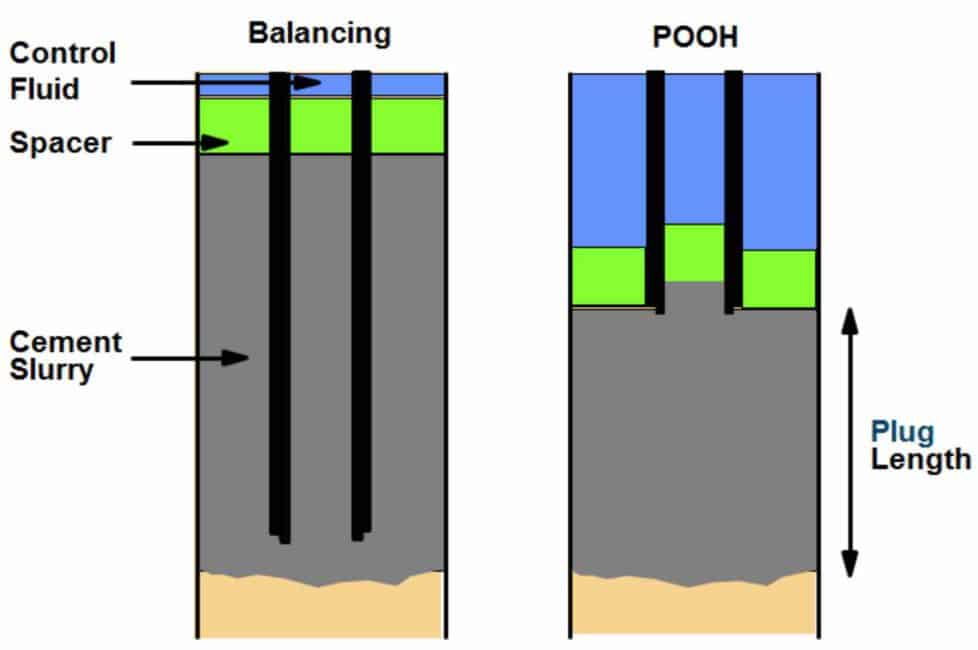
Volumetric calculations to place a balanced cement plug can be easily done based on the well schematic, pipe’s dimensions, open hole and casing sizes and the final cement plug length. See the next images for an example calculation.
It is common practice to slightly under-displace the plug (usually by 1–3 bbl). This practice avoids control fluid flow back on the rig floor after placement and allows the plug to reach a hydrostatic balance. Once the plug is balanced, the pipe is slowly pulled out of the cement to a depth above the plug, and excess cement is reversed out.
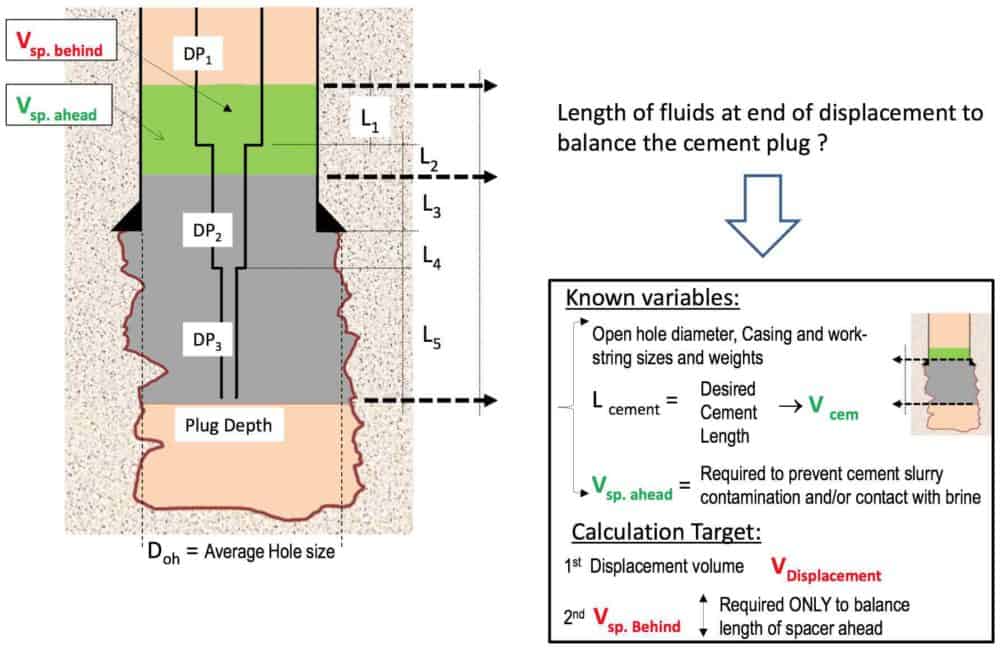
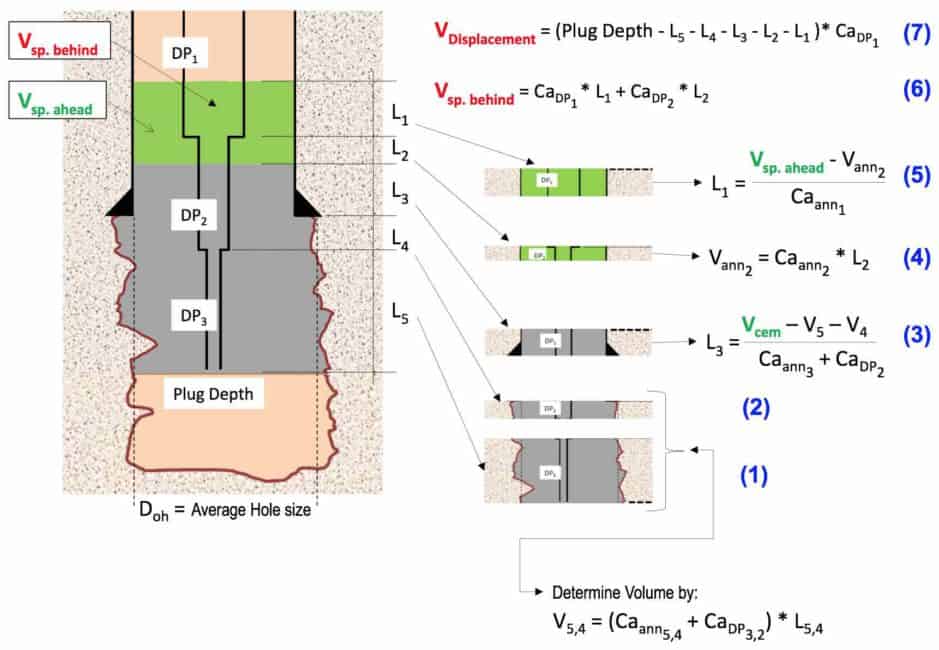
The maximum “recommended” cement plug length that can be placed in a single attempt is 200 meters.
In all my years, I never came across a good Excel sheet for the quick calculation of balanced cement plugs, they were always very specific or unable to consider variations in wellbore and drill pipe diameters. Well, I have finally completed one Excel sheet that I believe can be helpful. Now, I am saying this because I created this Excel sheet and it is working great for me, but I am sharing it with the objective to help people. I would like you to try it and give me your opinion or what improvements or changes it needs.
Finally, please remember it is a good practice to always double-check all job-related calculations, volumes, etc., with a team member, service company (
Balanced Plug Calculator (Donate to get the Excel Sheet)
| DP Details | Lenght (m) |
|---|---|
| 0.00 | |
| 0.00 | |
| 0.00 | |
| 0.00 | |
| 0.00 | |
| 0.00 | |
| 0.00 | |
| Total String Lenght (Check) | 0.00 |
| Length of Cement Plug after POOH | |
| Total Volume of spacer (bbl) | |
| Volume of Spacer ahead (bbl) | 0.00 |
| Under-displacement (bbl) | |
| TOC after POOH DP | 0.00 |
| Bottom of Plug | 0.00 |
| Cement Slurry Volume (bbl) | 0.00 |
| Average Cement Plug / wellbore Size (in) | 0.00 |
| Average Capacity (bbl/ft) | 0.00 |
| Average Capacity (bbl/m) | 0.00 |
| DP Volume | 0.00 |
| Annular Volume | 0.00 |
| Wellbore Volume with DP in | 0.00 |
| Wellbore Volume | 0.00 |
| Metal Displacement | 0.00 |
| Top (m) | Bottom (m) | ID (in) | OD (in) | Cap (bbl/ft) | Cap (bbl/m) | Volume (bbl) |
|---|---|---|---|---|---|---|
| 0.00 | 0.00 | 0.00 | 0.00 | 0.00 | ||
| 0.00 | 0.00 | 0.00 | 0.00 | |||
| 0.00 | 0.00 | 0.00 | 0.00 | |||
| 0.00 | 0.00 | 0.00 | 0.00 | |||
| 0.00 | 0.00 | 0.00 | 0.00 | |||
| 0.00 | 0.00 | 0.00 | 0.00 | |||
| 0.00 | 0.00 | 0.00 |
| DP/Hole Details | Top (m) | Bottom (m) | Hole/Casing Dia/ID (in) | Cap (bbl/ft) | Cap (bbl/m) | Volume (bbl) |
|---|---|---|---|---|---|---|
| 0.00 | 0.00 | 0.00 | 0.00 | 0.00 | ||
| 0.00 | 0.00 | 0.00 | 0.00 | 0.00 | ||
| 0.00 | 0.00 | 0.00 | 0.00 | 0.00 | ||
| 0.00 | 0.00 | 0.00 | 0.00 | 0.00 | ||
| 0.00 | 0.00 | 0.00 | 0.00 | 0.00 | ||
| 0.00 | 0.00 | 0.00 | 0.00 | 0.00 | ||
| 0.00 | 0.00 | 0.00 | 0.00 | 0.00 |
| Output Details | Lenght (m) | Top (m) | Vol in DP (bbl) | Vol in Annulus (bbl) |
|---|---|---|---|---|
| TOC with DP in | 0.00 | |||
| Length of Cement Plug with DP in | 0.00 | 0.00 | 0.00 | |
| Displacement to Balance | 0.00 | |||
| Underdisplacement | 0.00 | 0.00 | ||
| Volume of Cement inside with underdisplacement | 0.00 | 0.00 | ||
| TOC in DP with DP in and Underdisplacement | 0.00 | |||
| TOC in Annulus with DP in and Underdisplacement | 0.00 | |||
| Total Volume of Spacer | 0.00 | |||
| TOS after POOH | 0.00 | |||
| Length of Spacer after POOH | 0.00 | |||
| TOS with DP in | 0.00 | |||
| Volume of Spacer behind | 0.00 | 0.00 | ||
| Volume of Spacer Ahead | 0.00 | |||
| TOS in DP with DP in and Underdisplacement | 0.00 | |||
| TOS in Annulus with DP in and Underdisplacement | 0.00 | |||
| Summary Results | Volume (bbl) | Length (m) | Top (m) |
|---|---|---|---|
| Mud | 0.00 | 0.00 | 0.00 |
| Spacer Ahead | 0.00 | 0.00 | 0.00 |
| Cement Slurry (Annular) | 0.00 | 0.00 | 0.00 |
| Cement Slurry (DP) | 0.00 | 0.00 | 0.00 |
| Spacer Behind | 0.00 | 0.00 | 0.00 |
| Mud | 0.00 | 0.00 | 0.00 |
Instructions:
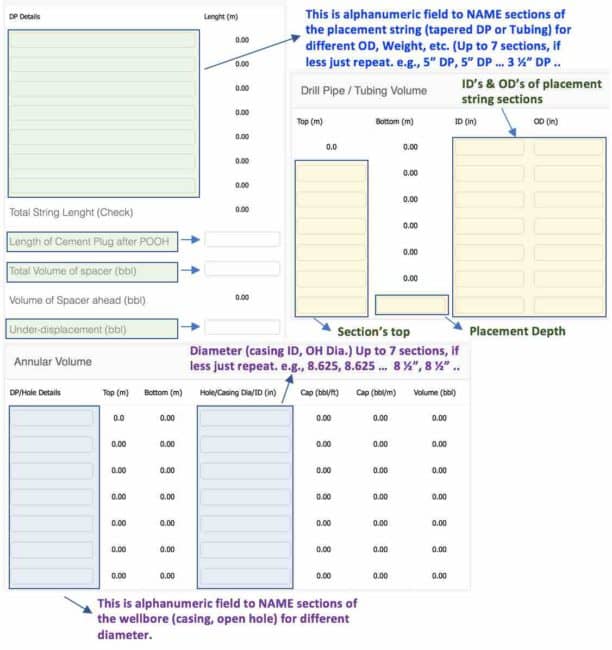
a) Use the 7 sections to input different placement string diameters and/or different wellbore diameters (casing IDs, OH diameter). For
b) Total volume of spacer (bbl) is the sum of spacer ahead and spacer behind. Change the total value until getting a round number for the volume ahead.
Please make a D
Revised version March-2024.
- Possibility to add hole excess
- Play scenarios for TOC and displacement, as a result to % excess in volume or OH
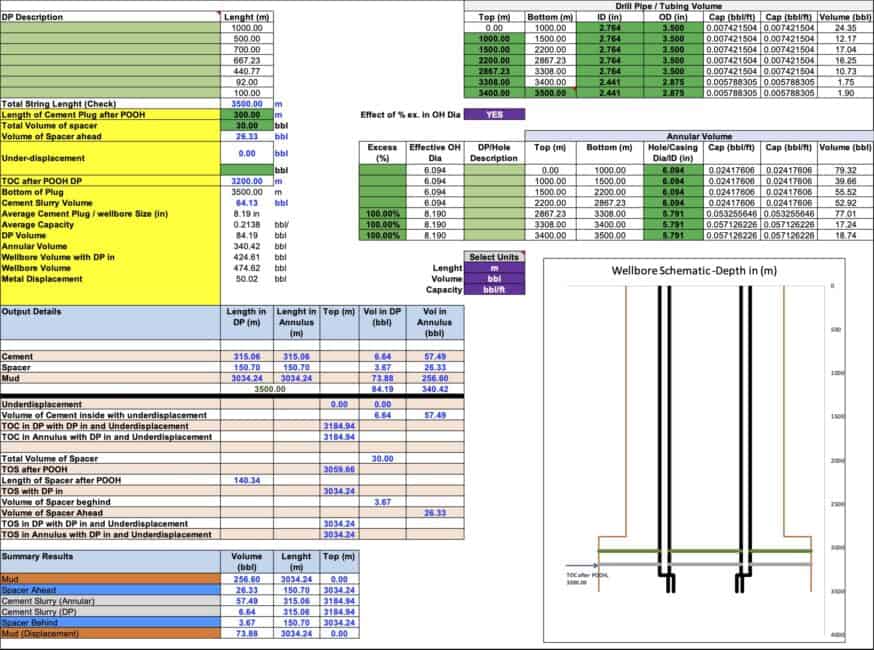
Recommended posts:
https://better-cementing-for-all.org/some-guidelines-for-cement-plugs
https://better-cementing-for-all.org/balance-to-succeed-a-case-of-cement-plugs-in-losses-situation
https://better-cementing-for-all.org/highly-deviated-and-horizontal-well-section-abandonment
Cheers
L. Diaz


Great article exactly what I learn in schlumberger and Halliburton and Put in práctic for each cement plug that I pump.
Thanks for your contribution Raul
Cheers
L. Diaz
I would like to try out your excel sheet if you would like to send it to me. Thanks
Hi Robert
Soon to be posted available to all
Cheers
L. Diaz
Could you please shear me the excel sheet?
Please contact me by email, no problem
Hi Leni,
This looks amazing. I have made my donation to get the excel file. what payment details do you need?
Thanks for your donation, I hope you enjoy the Excel sheet. BTW, I have a new version, able to use common oilfield units.
Cheers,
L. Diaz
Looks great.
I think I could do it on paper quicker than filling in the blanks.
H over c plus t
Sure you can Bobby,
Thanks for your input
Cheers
L. Diaz
During a complex multi-diameter hole, casing, rat hole, milled section and open hole with xs, cement plug job I came up with an idea to double-check the relatively complex calculations using a far simpler method. The sg of the steels we use is approximately 64.4 lb/gal (7.85 s.g.). If we know the combined weight of pipe inc. stinger for the length of the plug with the drill pipe out we can work out the displacement of the pipe from its weight lb/ft x ft (for each pipe section). Thus we can calculate the volume of cement displaced by the volume of steel pipe. That volume in a balanced plug will increase the height of the cement by the volume of the steel (gal) / (ann vol gal/ft+ id vol pipe gal/ft) in that section. If the same od/id stinger covers all the cement the additional volume is the displacement of the pipe. Then use the normal method to work out the increase of the height of the cement due to the pipe displacement. This saves calculating volumes for each section of the hole with different id’s with drill pipe in. Hope that I have explained this well.
Hi John, thanks for your contribution and I have to say that is clever indeed, plus very well explained for our readers.
In a way I used a similar approach with several conditional equations for variations of wellbore / Pipe OD with and without the pipe in. You can have a look at the Excel version of the calculator.
Cheers
L. Diaz
thank you
i’m really interested in your article
i’m working my thesis on the platform design and cementing design.
i have a preocupation for you, my adresse is ingenieur.ndaye@gmail.com
Hi Herve, Happy to help. Please let me know more details
Hello How Can I get the Excel copy of the above sheet please ?
Hi Mustafa, thanks for your interest in my blog in well cementing. I am sharing the Excel sheet version of the calculator via email following your kind donation to my website.
Cheers
L. Diaz
hello Mr. Lenin ,
i would love to know your judgement about the right position for OEDP while pumping a cement plug , which is more preferable for you to position the stirng across the loss zone or above it by some distance ?
i would like to know any means to message you if you do not mind please .
Hi Montader, thanks for your question.
In the case of total losses to a well-identified narrow (induced or natural fractures, faults, or similar) losses zone it is best to position the end of the DP above and the distance would depend on the severity and nature of the solution. Typically if your solution is something reacting in-situ you would increase the separation from the top of the losses zone; other than that (particle-based or LCM combination) you can place it right above. Another point of view to place the DP’s end above the losses zone is when having the solution circulating is considered counterproductive or catastrophic in nature (like a Calcium Chloride + Sodium silicate solution).
For partial losses, you can place the DP at the bottom of the losses zone, particularly for longer intervals, like a high-permeability layer.
You can use my personal email: dlenin@hotmail.com
Cheers,
L.Diaz
i would like also to know your thoughts on the perfect string position to spot and squeeze whether Coss_linking polymer pills or any other LCM pills for thief zone ? should it be on bottom (vugs, fractures on bottom and let’s say the string is a meter off bottom) then POOH to the top of LCM pill and squeeze it ?or to Place the string above loss zone some distance (10_30)m then spot the pill and squeeze it ? .
in the fields we tend to go with the second option which is to spot the pill above the loss zone and squeeze once left the bit . iwe had an argument about this matter some assumed if the string positioned above the top of loss zone , there is a possibility that part of pill would travel up the annulus instead of moving down to the loss zone therefore other pill could be required .
i wish that you could address this issue in some details and i will be patiently waiting for any words .
regards
Hi Montander,
As I previously mentioned, the position of the string depends on the severity of the losses (total or partial), and if you like the risks associated with the solution itself.
In the case of total losses, solution-fluids would flow to the path of least resistance and into the losses zone.
However, at some point, the fluid level can move up the annulus (due to the characteristics/volume of the solution fluids increasing the friction pressure at the losses zone), including the possibility of solution fluids moving behind the placement string. This possibility shall be risk-assessed and proper prevention and mitigation included in the design and placement procedure.
Some of these measures possibly including; the distance between the DP and the top of the losses zone, volume of fluids, modifying characteristics of the fluids (thickening or gelling time), use of pre and post-flushes, reciprocation of the DP, use of disposable tail-pipe, etc.
In any case, it is imperative to monitor the annulus for any returns during the treatment and be ready to close if required to ensure injection.
Hope this helps,
Cheers,
L. Diaz
many thanks sir for your time to reply my question i highly appreciate that
Thanks to you Montader, for supporting my website
very helpful
Thanks Sadeghi. Any way I can help, let me know
Do you have the Excel version of this Balanced Plug Calculator with graphic output in feet instead of meters?
If you do I would like to purchase
Hi Ronaldo, following your donation, I just sent you both excel sheet calculators. Any comment or question, please let me know.
L. Diaz
Hola Lenin, buenas tardes. Primero felicitaciones por tan excelente iniciativa en crear esta enlace web para consulta en cementaciones de pozos. estuve revisando el articulo “Balanced-plug method. Basic calculations”
Existe la posibilidad de poder obtener la hoja excel para el calculo de tapones balanceados?
Gracias
Enio Gutierrez
Claro, Enio, por favor escribe a mi email sin problemas.
L. Diaz
Hi Lenin, i have donated to your cause and can do more to help if so required. Could you send me the Excel version of your balanced plug calculator preferable in common oilfield units.
Thanks for your donation and support to my website.
L. Diaz
Hi, i am interested in the excel sheet but i am not able to make donation from where i am living now. Would you kindly advise pls.
Hi Ejat, let me know how I can help?
Hi Lenin,
I tried to donate in order to obtain the spreadsheet however the donate button does not work for me. Can you please email me the spreadsheet and tell me is there another method I can use to donate?
Hi Paul, just sent you an email with the sheet attached
Thanks a lot for this support to my website
Cheers
L. Diaz
I have made a donation today
Thanks for this contribution, Jesse
May I please get a copy of the excel sheet?
Hi jesse, thanks a lot for your donation and support. I sent to your email the excel sheet
Cheers,
L. Diaz
Hi,
I would like to test the excel.
Please let me know how to proceed.
Thx,
Tom
The sheet is tested already
Please send me an email to explain to proceed
Hi there, how can I get your spreadsheet? And in ft?
Hi Tom
It comes multi units
Send me an email and can explain
I tried to donate in order to obtain the spreadsheet however the donate button does not work for me. Can you please email me the spreadsheet and tell me is there another method I can use to donate?
Hi Kursat,
Please send me an email and I will explore what the problem was
paypal was banned in my country years ago so i can’t donate i need this excel file very much. what should i do
Please send me an email to dlenin@hotmail.com
Hi,
Could i get the excel sheet please?
Thank you
A
Please send me an email
Thanks
Hi Lenin
I made my donation through pay pal. Would I be able to receive the excel sheet?
Thank you for your help!
Thanks Kevin, any questions regarding the use of the sheet, please let me know
hello. would like a email for donation and plug calculations excel spreadsheet. thank u
Please use the paypal link
Hi,
Could i get the excel sheet please?
Thank you . oilfield units
Glad you find this useful. Please send me an email
Dear I need this Excel spread sheet. I can donate but tell me any other convenient way for me like if I could get account # then I may transfer online this donation.
Hi can you please share a copy of your excel sheet for balance cement plugs?
Lenin,
I will send you a donation for the spread sheet for imperial and metric. I look forward in using this it looks incredible.
Hi there, I’ve just donated to get the sheet, but not sure if this is still working. Hoping it is..🙏🏻.
It did, thanks for contact me and yoru donation
Hi Lenin
I would like a copy of your updated Balanced Plug spreadsheet and will make a donation. Please confirm if still available and any other info. Regards
Hi Ian, yes. Thanks for the contact. I hope you enjoy the calculator
All sent by email, thanks
Hi Lenin,
How can I get this latest excel sheet. Thanks
Regards,
Han
Please send me an email
Hello I would love to try your excel sheet please send it to me.
Hi Lenin,
How can I get this latest excel sheet. Thanks
Regards,
rajesh kumar yogi
Hi I would like to get the XL sheet please.
Hello, could you share with me the Balanced Plug Calculator
thanks
Transaction ID: I-9JFLYX0HW11T
Please send email
Hello, how do i donate to try your excel sheet?
Please send email
Please share the excel sheet. Let me know how to donate.
Please send me email
Dear Sir,
I made a donation, please could you share the excel sheet thank you so much,
Nicolas
All Good Nicolas, Thanks
Any issues let me know, by email